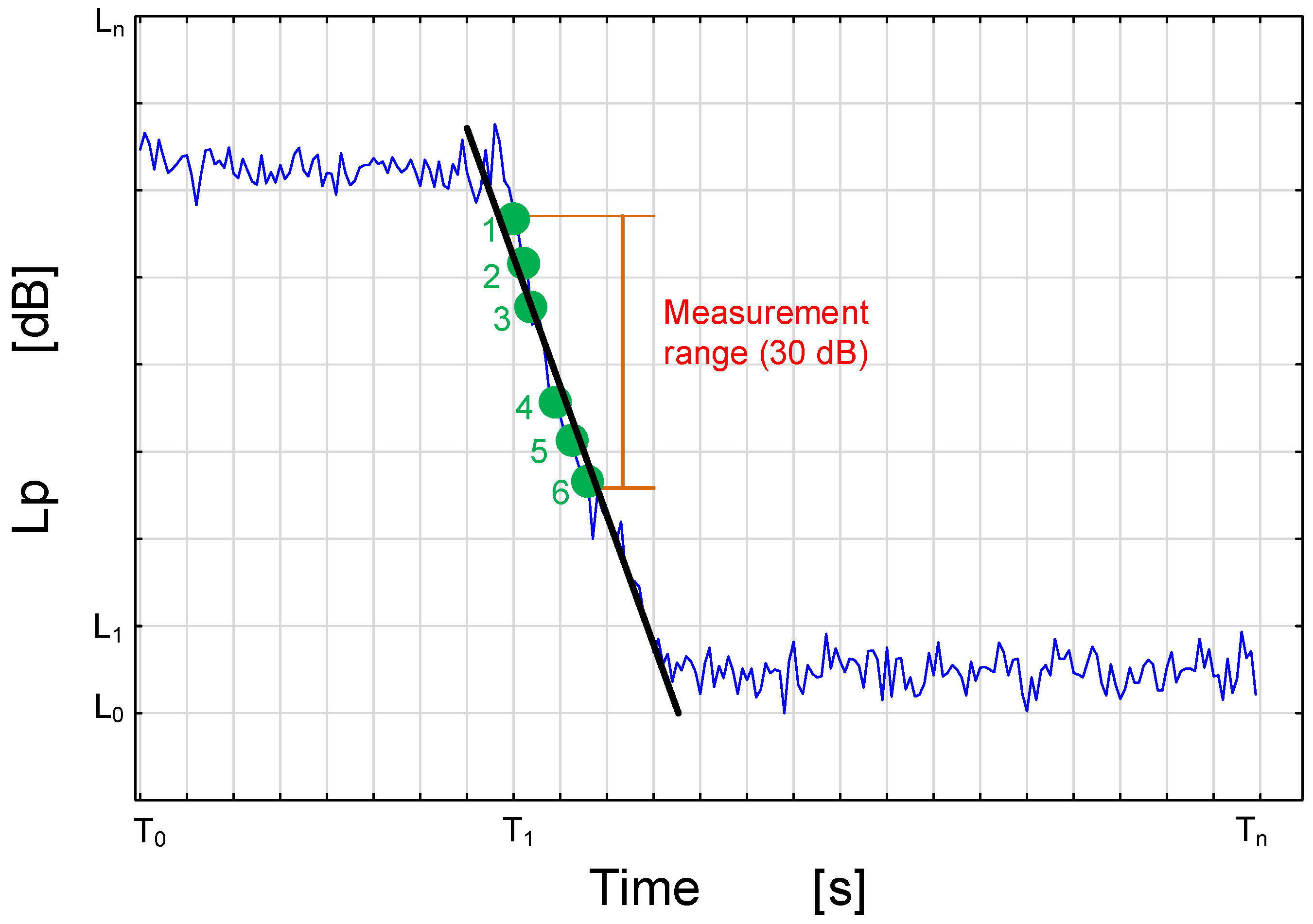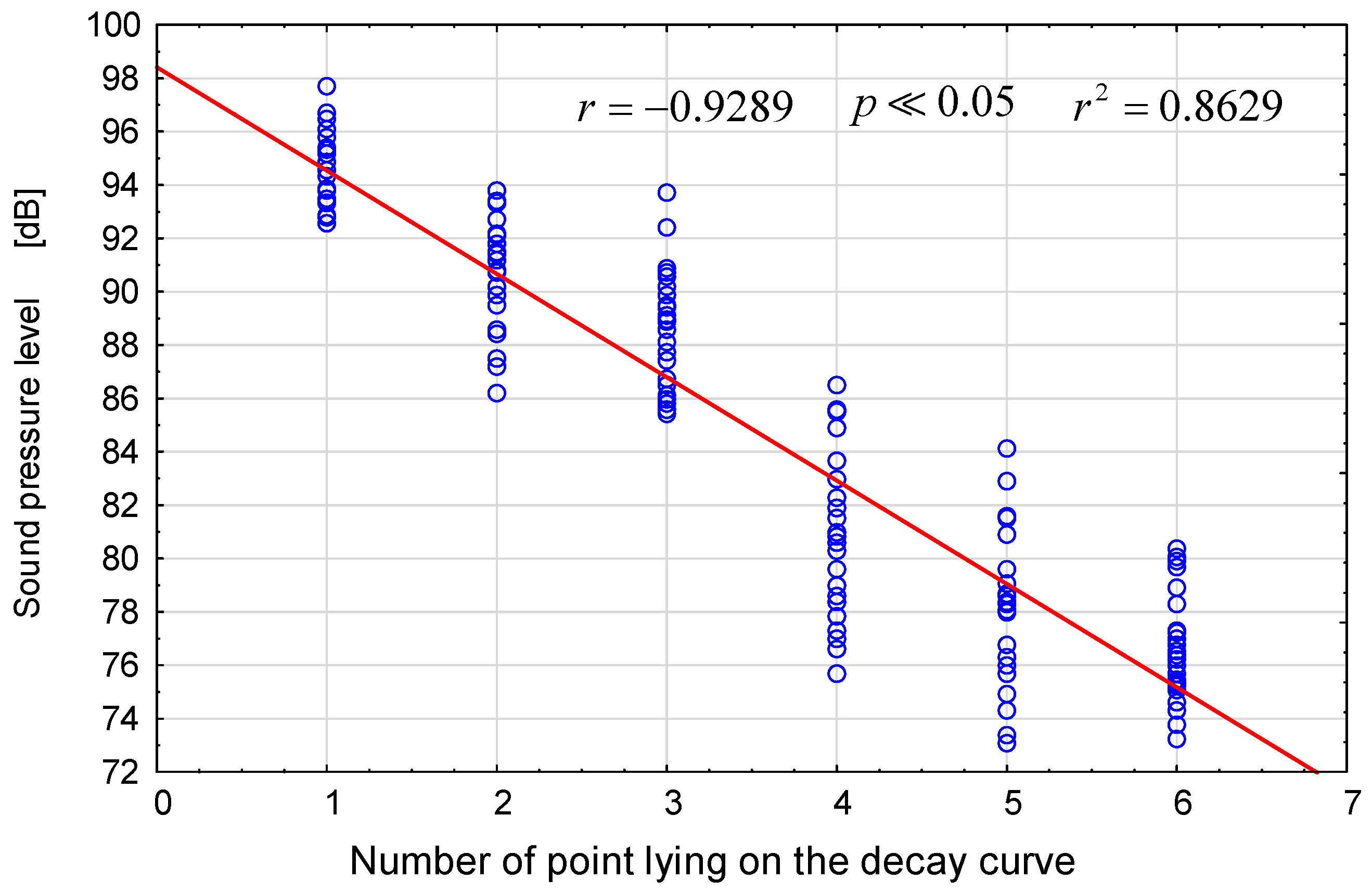Determination of the Reverberation Time Using the Measurement of Sound Decay Curves
Abstract
:Featured Application
Abstract
1. Introduction
2. Methodology
2.1. Measuring Devices
- The transmission part of the test system consisted of the following elements: an omnidirectional sound source, a generator of pink and white noise, together with an amplifier manufactured by Svantek.
- The reception part of the test system comprised the following elements: a four-channel sound level gauge SVAN 958 made by Svantek; two 1/200 microphones, type SV22, made by Svantek; two 1/200 microphone preamplifiers, type SV22, made by Svantek; an acoustic calibrator, type SV03A, made by Svantek; a PC computer with the software SvanPC + Software Official 1.0.21e. The tools had valid calibration certificates. They were Class 1 free-field microphones.
2.2. Reverberation Chamber
2.3. Measurement in the Classroom
2.4. Determination of Reverberation Time
2.4.1. The First Averaging Method
- We find the sound pressure level reduced by 5 dB from the initial value, which is the level of sound pressure at the moment when the sound source is turned off. The value is referred to as Lp, and time tp is read out for it (horizontal axis).
- We find the value of the sound pressure level reduced by 25 dB from the Lp value, which is referred to as Lk, and time tk is read out for it (horizontal axis).
- The reverberation time is determined based on the following relationship:
- d—sound decay rate in dB/s, ;
- ΔL—difference in sound levels;
- Δτ—increment of sound decay time.
- 4.
- The reverberation times for all measurements are arithmetically averaged, and the standard uncertainty is determined.
2.4.2. The Second Averaging Method
2.5. Measurement Uncertainty
2.5.1. Measurement Uncertainty According to the First Averaging Method
2.5.2. Measurement Uncertainty According to the Second Averaging Method
2.5.3. Proof of Formula (10)
3. Results and Discussion
3.1. Results of Laboratory Measurements
3.1.1. Results of the First Method
- T1 = 1.176; T2 = 1.519; T3 = 1.117; T4 = 1.371; T5 = 1.429; T6 = 1.277; T7 = 1.429; T8 = 1.250; T9 = 1.326; T10 = 1.484; T11 = 1.399; T12 = 1.304; T13 = 1.084; T14 = 1.091; T15 = 1.118; T16 = 1.304; T17 = 1.311; T18 = 1.371; T19 = 1.319; T20 = 1.484; T21 = 0.921; T22 = 1.543; T23 = 1.200; T24 = 1.364.
- T1 = 1.180; T2 = 1.099; T3 = 1.104; T4 = 1.233; T5 = 1.077; T6 = 0.963; T7 = 1.077; T8 = 1.117; T9 = 1.321; T10 = 1.077; T11 = 1.117; T12 = 1.224; T13 = 0.955; T14 = 1.059; T15 = 1.123; T16 = 1.214; T17 = 1.329; T18 = 1.207; T19 = 1.420; T20 = 1.091; T21 = 1.111; T22 = 1.356; T23 = 1.099; T24 = 1.111.
- T1 = 1.023; T2 = 1.123; T3 = 1.061; T4 = 1.099; T5 = 1.084; T6 = 1.000; T7 = 1.212; T8 = 1.160; T9 = 1.129; T10 = 1.055; T11 = 1.011; T12 = 1.118; T13 = 1.099; T14 = 1.129; T15 = 1.160; T16 = 1.148; T17 = 1.082; T18 = 1.105; T19 = 1.200; T20 = 0.952; T21 = 0.943; T22 = 1.088; T23 = 1.186; T24 = 1.040.
3.1.2. Results of the Second Method
3.2. Measurement Results of the Classroom
3.2.1. Results of the First Method
3.2.2. Results of the Second Method
4. Conclusions
- The averaging method of decay curves affects the reported reverberation time value. This influence is so significant that it may affect the acoustic qualification of rooms for which the reception of verbal sound and, above all, speech intelligibility are important.
- The proposed averaging method of decay curves using linear regression is innovative and seems to be the best way to estimate the reverberation time based on the measurement of decay curves.
- The applied estimation method of measurement uncertainty using Formula (10) for the estimation of sound decay time averaged by means of the linear regression of decay curves seems to be the most reasonable solution.
Funding
Institutional Review Board Statement
Informed Consent Statement
Data Availability Statement
Conflicts of Interest
References
- Reinten, J.; Braat-Eggen, P.; Hornikx, M.; Kort, H.S.M.; Kohlrausch, A. The indoor sound environment and human task performance: A literature review on the role of room acoustics. Build. Environ. 2017, 123, 315–332. [Google Scholar]
- Sabine, W.C. Collected Papers on Acoustics; Harvard University Press: Cambridge, MA, USA, 1922. [Google Scholar]
- Nowoświat, A.; Olechowska, M. Investigation studies on the application of reverberation time. Arch. Acoust. 2016, 41, 15–26. [Google Scholar] [CrossRef] [Green Version]
- Montoya, J.C. Comparison and analysis of the methods defined by ASTM standard E2235-04, ISO 3382-2-2008 and EASY acoustical modeling software to determine reverberation time RT60 in ordinary rooms. J. Acoust. Soc. Am. 2017, 142, 2508. [Google Scholar] [CrossRef]
- Rosenhouse, G. Reverberation time analysis for nonrectangular rooms using the Monte Carlo method. J. Acoust. Soc. Am. 2017, 141, 3711. [Google Scholar] [CrossRef]
- Meissner, M. Acoustics of small rectangular rooms: Analytical and numerical determination of reverberation parameters. Appl. Acoust. 2017, 120, 111–119. [Google Scholar] [CrossRef]
- Zhou, X.; Späh, M.; Henghst, K.; Zhang, T. Predicting the reverberation time in rectangular rooms with non-uniform absorption distribution. Appl. Acoust. 2021, 171, 107539. [Google Scholar] [CrossRef]
- ISO 3382-2:2008; Acoustics—Measurement of Room Acoustic Parameters—Part 2: Reverberation Time in Ordinary Rooms. International Organization for Standardization: Geneva, Switzerland, 2008.
- Prato, A.; Casassa, F.; Schiavi, A. Reverberation time measurements in non-diffuse acoustics field by the model reverberation time. Appl. Acoust. 2016, 110, 160–169. [Google Scholar] [CrossRef]
- Howard, A. Acoustics and Psychoacoustics, 4th ed.; Focal Press: Oxford, UK; Boston, MA, USA, 2009. [Google Scholar]
- Wszołek, T. Uncertainty of sound insulation measurement in laboratory. Arch. Acoust. 2007, 32, 271–277. [Google Scholar]
- Scrosati, C.; Scamoni, F.; Zambon, G. Uncertainty of façade sound insulation in buildings by a Round Robin test. Appl. Acoust. 2015, 96, 27–38. [Google Scholar] [CrossRef]
- Nowoświat, A.; Olechowska, M. Experimental validation of the model of reverberation time prediction in a room. Buildings 2022, 12, 347. [Google Scholar] [CrossRef]
- Nowoświat, A. Impact of temperature and relative humidity on reverberation time in a reverberation room. Buildings 2022, 12, 1282. [Google Scholar] [CrossRef]
- Hopkins, C. Sound Insulation, 1st ed.; Elsevier Ltd.: Amsterdam, The Netherlands, 2007. [Google Scholar]
- Davy, J.L. The variance of Decay rates at low frequency. Appl. Acoust. 1988, 23, 63–79. [Google Scholar] [CrossRef]
- Čurović, L.; Murovec, J.; Novakowvić, T.; Prislan, R.; Prezerlj, J. Stockwell transform for estimating Decay time at low frequencies. J. Sound Vib. 2021, 493, 115849. [Google Scholar]
- Prato, A.; Schiavi, A.; Ruatta, A. A modal approach for impact sound insulation measurement at low frequency. Build. Acoust. 2016, 23, 110–119. [Google Scholar] [CrossRef]
- Ljunggren, F.; Simmons, C.; Hagberg, K. Correlation between sound insulation and occupants perception-proposal of alternative single number rating of impact sound. Appl. Acoust. 2014, 85, 57–68. [Google Scholar] [CrossRef]
- Öqvist, R.; Ljunggren, F.; Johnsson, R. Walking sound annoyance vs. Impact sound insulation from 20 Hz. Appl. Acoust. 2018, 135, 1–7. [Google Scholar] [CrossRef]
- Xiang, N.; Jasa, T. Evaluation of Decay Times in coupled spaces: An efficient search algorithm within the Bayesian framework. J. Acoust. Soc. Am. 2006, 120, 3744–3749. [Google Scholar]
- Xiang, N.; Goggans, P.M.; Jasa, T.; Robinson, P. Bayesian characterization of multiple-slope sound Energy decays in coupled-volume systems. J. Acoust. Soc. Am. 2011, 129, 741–752. [Google Scholar] [CrossRef]
- Martellotta, F.; Álvarez-Morales, L.; Girón, S.; Zamarreño, T. An investigation of multi-rate sound Decay under strongly non-diffuse conditions: The crypt of the Cathedral of Cadiz. J. Sound Vib. 2018, 421, 261–274. [Google Scholar]
- Balint, J.; Muralter, F.; Nolan, M.; Jeong, C.-H. Bayesian Decay time estimation in a reverberation chamber for absorption measurements. J. Acoust. Soc. Am. 2019, 146, 1641–1649. [Google Scholar]
- Meissner, M. Application of modal expansion method for sound prediction in enclosed spaces subjected to boundary excitation. J. Sound Vib. 2021, 500, 116041. [Google Scholar]
- Nowoświat, A.; Dulak, L. Impact of cement dust pollution on the surface of sound-absorbing panels on their acoustic properties. Materials 2020, 13, 1422. [Google Scholar] [CrossRef] [Green Version]
- Nowoświat, A.; Olechowska, M. Estimation of reverberation time in classrooms using the residua minimization method. Arch. Acoust. 2017, 42, 609–617. [Google Scholar] [CrossRef] [Green Version]













Disclaimer/Publisher’s Note: The statements, opinions and data contained in all publications are solely those of the individual author(s) and contributor(s) and not of MDPI and/or the editor(s). MDPI and/or the editor(s) disclaim responsibility for any injury to people or property resulting from any ideas, methods, instructions or products referred to in the content. |
© 2023 by the author. Licensee MDPI, Basel, Switzerland. This article is an open access article distributed under the terms and conditions of the Creative Commons Attribution (CC BY) license (https://creativecommons.org/licenses/by/4.0/).
Share and Cite
Nowoświat, A. Determination of the Reverberation Time Using the Measurement of Sound Decay Curves. Appl. Sci. 2023, 13, 8607. https://doi.org/10.3390/app13158607
Nowoświat A. Determination of the Reverberation Time Using the Measurement of Sound Decay Curves. Applied Sciences. 2023; 13(15):8607. https://doi.org/10.3390/app13158607
Chicago/Turabian StyleNowoświat, Artur. 2023. "Determination of the Reverberation Time Using the Measurement of Sound Decay Curves" Applied Sciences 13, no. 15: 8607. https://doi.org/10.3390/app13158607




